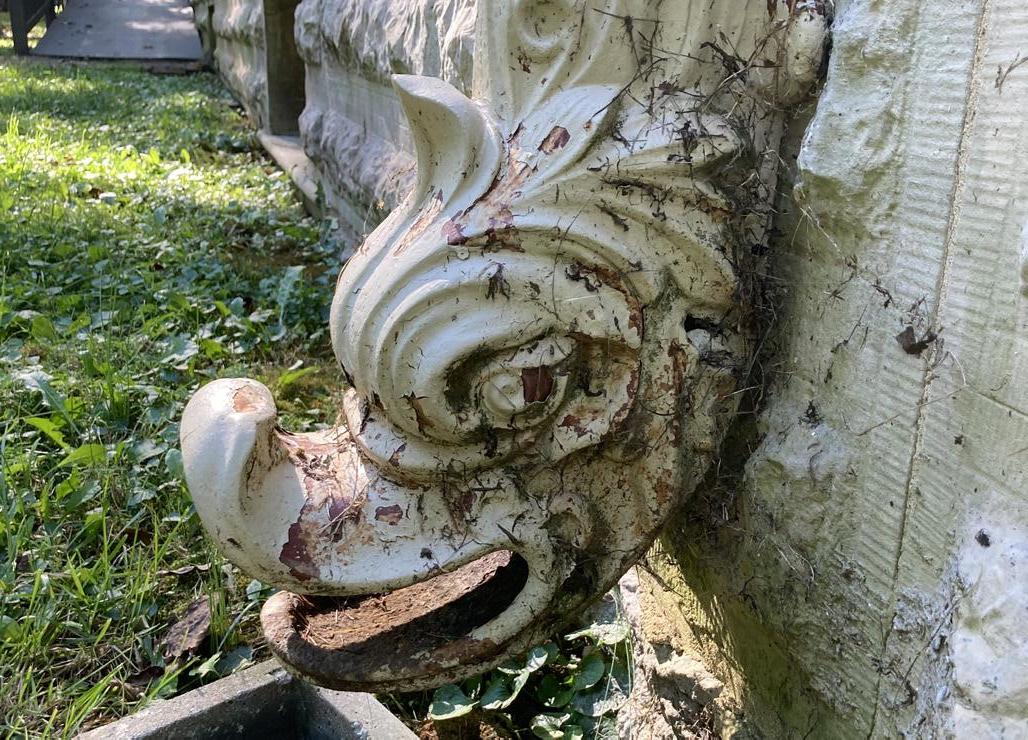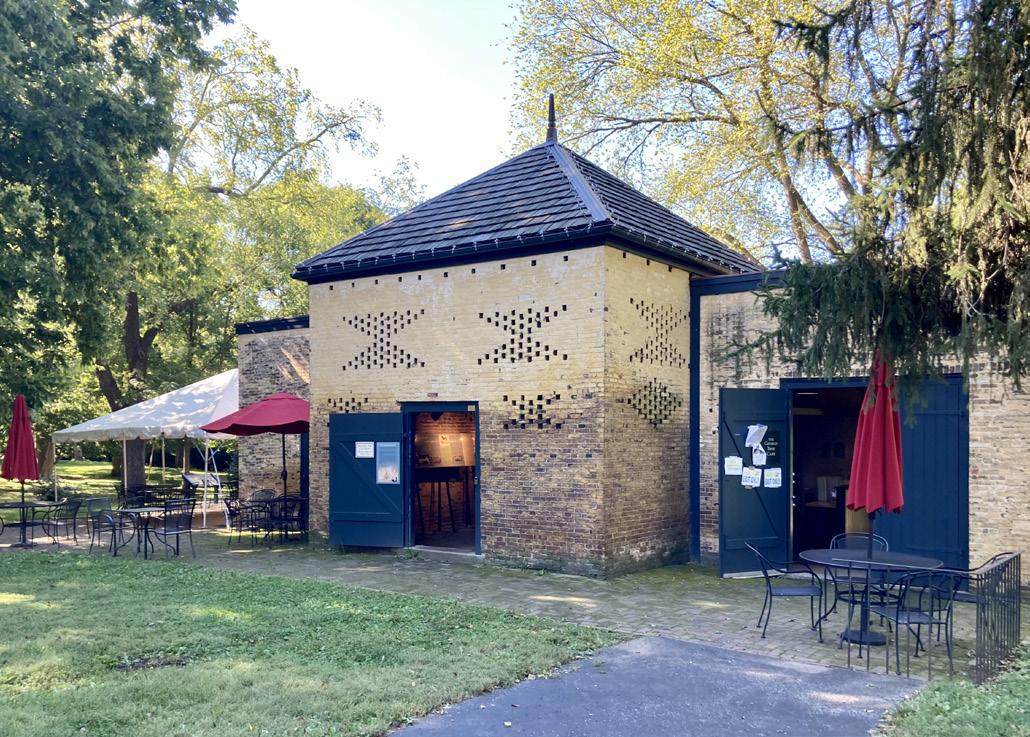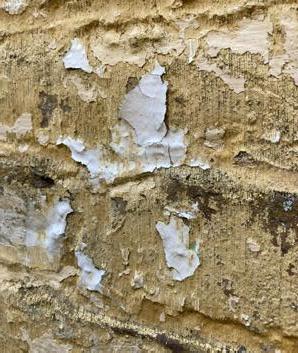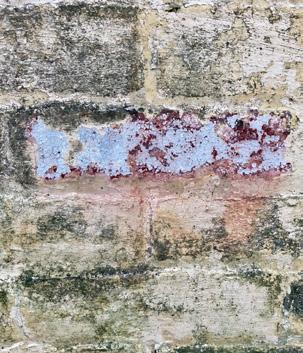
4 minute read
Ice Houses
figure 11. Corroding cast-iron heraldic dolphin
One of Ashland's Italianate exterior elements are the cast-iron heraldic dolphin downspouts.38 Due to external forces, the cast iron downspout is heavily corroded (rustjacking), and the protective coating is flaking off the cast iron. Today Alkyd paints are used to form protective coatings for metals; however, unlike the traditional linseed oil paints that contained lead, Alkyd paints are not as durable or long-lasting. Since this cast iron element is a waterspout, applying a high performing zinc-rich primer will prolong protection. A practical method is to use a zinc-rich primer, add an epoxy base coat, and apply two urethane coatings layers. When applying paint to the heraldic dolphin downspouts, the most effective application technique is to brush the paints + coatings onto the clean cast-iron surface.39
Advertisement
38. “Unusual Architecture and Dolphins at Ashland,” History of a House Museum, March 6, 2017, https://historyofahousemuseum.com/2017/03/06/unusual-architecture-and-dolphins-at-ashland-3/. 39. John G. Waite, “Preservation Brief 27: The Maintenance and Repair of Architectural Cast Iron,” National Parks Service, accessed November 1, 2020, https://www.nps.gov/tps/how-to-preserve/briefs/27-cast-iron. htm.

figure 11. Discoloration + stains + biological attack on exterior of Smokehouse
Exterior of the Smokehouse + Keeper’s Cottage.
The smokehouse and the keeper’s cottage are historic brick buildings coated with whitewash tinted with yellow pigment. During the 1991 renovation, the conservators formulated a “whitewash” or known as “limewash” recipe inspired by the historic whitewash used on the Ashland Mansion and other buildings during James’s era.40 Limewash consists of lime putty and water to create a mixture to apply to the historic masonry walls. Builders would produce historic lime putty from locally burned lime to create “quicklime,” and then combined with water, resulting in a creamy consistency.41
Limewash coatings in 19th-century buildings were popular not only because the
40. Eric Brooks, interview by author. 41. Sloane Taliaferro, “Documentation and Testing of Nineteenth-Century Limewash Recipes in the United States” (master’s thesis, Columbia University), 6.
coating was attractive but also for its beneficial properties. Property owners had limewash applied to buildings and barns because of its antiseptic, alkalinity, and protective properties. Limewash is considered a “healthy” and “sanitary” material that prevents bacteria’s growth and decreases the presence of disease and illness within its proximity.42 Limewash acts as a sacrificial material that absorbs the historic bricks, unlike other paints + coatings that only adhere to the substrate’s surface. Historic brick is much softer than today’s brick, making it prone to a faster deterioration rate. Once limewash thoroughly penetrates the masonry wall, it strengthens and consolidates the soft + porous historic bricks to prolong deterioration. Furthermore, limewash is a permeable coating that helps masonry walls breathe, which means that it quickly cycles water + moisture through the substrate and coating to prevent efflorescence or subflorescence.




figure 12. Peeling on exterior of keeper’s cottage (top left); figure 13. Efflorescence on exterior of smokehouse (middle); figure. 14. chalking on exterior of smokehouse; figure 15. Green surface stains from biological attack of fungi on keeper’s cottage Limewash is coated on buildings approximately three to five times using designated limewash brushes and reapply limewash yearly.43 When examining these structures, various surface conditions to the limewash coating were apparent such as discoloration, chalking, peeling, vanadium stains, and biological growth. After researching limewash, it is evident that these structures are not adequately maintained. The previously mentioned conditions were preventable if only these structures were routinely cleaned and coated yearly.44 Overall, the combination of the limewash coating surface failures is considered “class III.” The entire exterior surface will need to be completely restored with a few fresh coats of limewash.
To begin this process, the biological growth (mold, mildew, and algae) located at the base of the keeper’s cottage will need to be cleaned off. Biological fungi can thrive in damp and shady areas; also, not having efficient drainage systems below the building’s base can cause moisture to accumulate. A cleaning solution that contains 1 cup of non-ammoniated detergent, 1 quart of bleach and 1 gallon of water will help remove the biological growth. Scrub the cleaning solution with a medium-soft bristled brush, and then rinse off the affected area with water.45
After removing the biological growth, detach the flakes of peeling limewash with a paint scraper. Next, work on removing the powdery chalk, which is on all exterior surfaces of these buildings. To mention, “moderate chalking” is a natural process of how paints + coatings age;46 however, excessive chalking is not good because limewash slowly disintegrates, leaving the soft + porous historic brick vulnerable to deterioration. Chalking is caused either by the formulation of the paint or by excessive exposure to UV rays.47 Again, to remove chalking, create a cleaning solution that contains ½ household detergent to 1 gallon of water and then scrub off the powdery film with a medium-soft bristle brush. Rinse the masonry walls with
43. Taliaferro, “Documentation and Testing of Nineteenth-Century Limewash Recipes in the United States,” 10.
44. Taliaferro, “Documentation and Testing of Nineteenth-Century Limewash Recipes in the United States,”
11.
work.” 45. National Parks Service, “Preservation Brief 10: Exterior Paint Problems on Historic Wood-
46. National Parks Service, “Preservation Brief 10: Exterior Paint Problems on Historic Wood-




